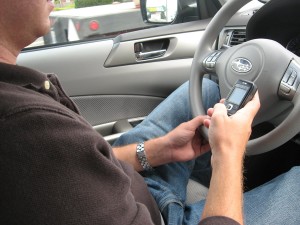The Phillips Law Firm makes an unprecedented move this month in handing out its notable “What Were You Thinking!?” award. Remember, it’s never a good thing to receive this award because it’s a reminder to the general public that you took some form of carelessness that endangered a member of your community. So, the unprecedented move is? We’re proud (actually abhorred) to announce this month that we have co-recipients for our monthly trophy.
Drunken, Texting Driver…What Were You Thinking!?
A Bonney Lake bicyclist was hurt at the end of August after being struck by a drunken and texting motorist. The accident occurred at approximately 10 p.m. on state Route 410 at 171st Avenue East. The 53-year-old bicyclist suffered a broken ankle and several abrasions from the collision.
Washington State Patrol troopers eventually arrested the automobile driver. He was a 23-year-old resident of Lake Tapps. According to troopers, he was drunk and sending a text message when the collision occurred. The driver was later booked into the Pierce County Jail on suspicion of vehicular assault.
Drunk driving is horrible. Texting while driving is horrible. To add insult to injury, the drunken, texting motorist failed to stop after the accident took place. The driver eventually returned to the scene once another motorist informed him that he had hit a cyclist.
Texting Driver #2…What Were You Thinking!?
Our second award goes out to a teenage driver that struck and injured an unidentified 63-year-old female pedestrian in Arlington. The accident took place in early September in the 17100 block of McRae Road Northwest. The time of the incident was approximately 8:45 a.m.
The driver, age 16, was texting while operating her motor vehicle. As she was texting, the side mirror of her auto struck the pedestrian and knocked her to the ground. The pedestrian was taken to Providence Medical Center. She suffered a broken hand, a broken hip and arm injuries as a result of the incident.
Unlike our drunken, texting driver above, we should note that the teen driver immediately pulled over following the accident and ran to check on the injured pedestrian. “I was texting,” she said. “I’m sorry.” While the apology was a noble act, the act of texting while driving is a dishonorable one.
Texting While Driving is Illegal Folks!
Washington law unequivocally prohibits drivers from using cell phones or wireless devices while driving. Washington created its cell phone law on June 10, 2010 in the hopes of deterring the use of cell phones while driving. Under this law, police can pull a motorist over if they spot a driver holding a cell phone to his ear or texting while driving. If found guilty of this traffic offense, a driver can face a $124 fine. Additional Fines and other penalties can easily result if a crash is involved.
Why is Texting While Driving Illegal?
Texting while driving is illegal because the act is very, very, very dangerous. For the doubters among us, consider the following:
- According to the National Safety Council, as of this year alone, there have been over 500,000 automobile crashes that involve drivers using cell phones and texting. This translates into one crash occurring every 30 seconds.
- As estimated by www.distraction.gov (the official U.S. Government website for distracted driving), over 3,300 people were killed in distraction-affected vehicle crashes in 2012.
- Thirteen percent of all drivers in the United States, between the ages of 18 and 20, admit to texting or talking on their cell phone at the time of an accident.
Drive Smart!
Regardless of the above statistics, many of us cannot resist the urge to talk on our cell phones or text while driving. The truth though is that these acts can result in injuries to innocent people. This took place in Bonney Lake, it took place in Arlington, and it can take place in your community unless we all become smarter drivers. Lead by example and resist the urge to use your cell phone while behind the wheel. Just drive smart! Smart drivers are responsible drivers and they help increase the safety of us all.
Please note that if you’ve been injured in an automobile accident by a motorist that was using a cell phone, you have the right to file a civil suit to recover any injuries you may have sustained. The skilled attorneys at Phillips Law Firm can help you exercise this right. They’re here for you and they’re ready to provide justice today!












![By Intel Free Press [CC-BY-SA-2.0 (http://creativecommons.org/licenses/by-sa/2.0)], via Wikimedia Commons Texting While Driving - Washington State](http://upload.wikimedia.org/wikipedia/commons/thumb/d/d6/Texting_while_Driving_%28March_28%2C_2013%29.jpg/800px-Texting_while_Driving_%28March_28%2C_2013%29.jpg)